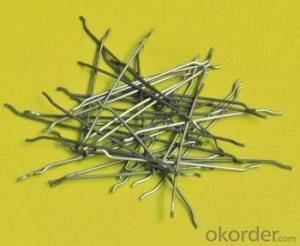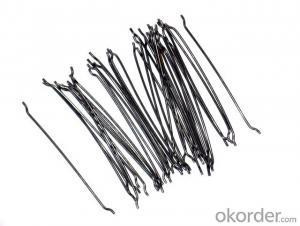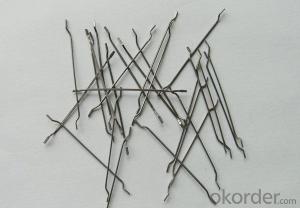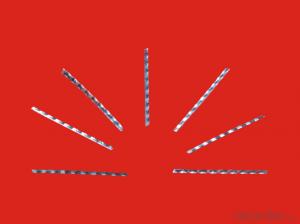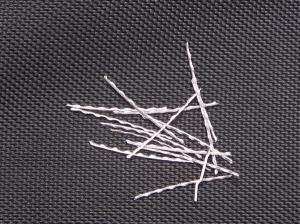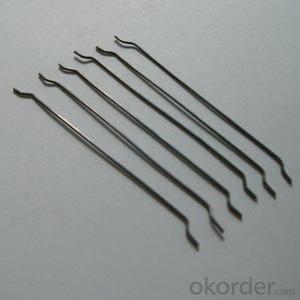Melt Extract Stainless Steel Fiber - Loose CNBM International Corporation
- Loading Port:
- Tianjin
- Payment Terms:
- TT OR LC
- Min Order Qty:
- 2000 kg
- Supply Capability:
- 30000 kg/month
OKorder Service Pledge
OKorder Financial Service
You Might Also Like
Quick Details
Place of Origin: Jiangsu, China (Mainland)
Model Number: HT-MC
Material: Color Steel
certificated: ISO 9001
Specifications
ISO 9001 certificated
2.70% for Europe, Middle Asia, America market
3.Have the most number of steel fiber machine in china
1. Material: low carbon steel wire or stainless steel
2.Diameter: 0.4mm-1.0mm
3.Length: meet your requirements
4.tensile strength >1000Mpa
6.Feature: excellent tensile,high tenacity,against cracking,impact and fatigue
7.Uses: highway road surface,tunnel,building,airport road surface and so on .
Straight Steel Fiber
1.ISO 9001 certificated
2.70% for Europe, Middle Asia, America market
3.Have the most number of steel fiber machine in china
Picture

Steel fiber
FAQ
certificated: ISO 9001
Technical advantages of Daye steel fiber:
A. Improve mechanical performance of concrete
B. Provide uniform distribution throughout concrete with excellent mixing
C. No balling or caking by adopt correct mixing method
D. Reduce concrete volume
E.Save construction time and cost
F.Reduce excavation volume
G.Available for jointless floor.
- Q: Can melt extract stainless steel fiber be used in refractory concrete applications?
- Yes, melt extract stainless steel fiber can be used in refractory concrete applications. Its high temperature resistance and ability to improve the mechanical properties and durability of concrete make it a suitable reinforcement material for refractory concrete.
- Q: How does melt extract stainless steel fiber impact the early-age cracking of concrete?
- Melt extract stainless steel fiber reduces the early-age cracking of concrete by improving its tensile strength and crack resistance. The fibers effectively distribute and restrain the shrinkage stresses within the concrete, preventing the formation of significant cracks during the early stages of curing. This reinforcement also enhances the overall durability and longevity of the concrete structure.
- Q: What is the effect of melt extract stainless steel fiber on the impact resistance of concrete?
- The effect of melt extract stainless steel fiber on the impact resistance of concrete is that it significantly improves the concrete's ability to withstand impact forces. The inclusion of stainless steel fibers in the concrete matrix enhances its resistance to cracking and spalling, thereby increasing its overall durability and strength. These fibers act as reinforcement, distributing the impact load more evenly throughout the concrete structure, reducing the likelihood of sudden failure or damage. This ultimately leads to improved impact resistance and a longer service life for the concrete.
- Q: Is melt extract stainless steel fiber suitable for use in architectural concrete?
- Yes, melt extract stainless steel fiber is suitable for use in architectural concrete. It provides enhanced durability, crack resistance, and improved structural integrity in concrete constructions. Additionally, it helps to reinforce the concrete, increasing its longevity and reducing maintenance costs.
- Q: Can melt extract stainless steel fiber be used in architectural concrete?
- Indeed, melt extract stainless steel fiber is a viable option for incorporating into architectural concrete. Its utilization is widespread in architectural concrete projects owing to its impressive strength and durability. By reinforcing the concrete, it aids in bolstering its resistance against cracking, shrinkage, and impact, thereby augmenting the overall performance and lifespan of the structures. Moreover, the inclusion of melt extract stainless steel fiber in architectural concrete also fortifies its resistance against corrosion, rendering it suitable for implementation in architectural endeavors that face exposure to harsh environmental conditions. In summary, the integration of melt extract stainless steel fiber into architectural concrete not only enhances its structural integrity but also elevates its aesthetic allure.
- Q: What is the effect of melt extract stainless steel fiber on the fire resistance of concrete?
- The addition of melt extract stainless steel fiber to concrete has a significant effect on the fire resistance of the material. Stainless steel fibers are known for their high melting point and excellent heat resistance properties. When incorporated into concrete, these fibers provide enhanced fire resistance by improving the material's overall thermal conductivity and reducing the risk of spalling, cracking, or structural failure during a fire event. The stainless steel fibers act as reinforcement within the concrete matrix, increasing its tensile strength and preventing the propagation of cracks caused by thermal expansion and contraction. This reinforcement effect allows the concrete to maintain its structural integrity for a longer period of time under high temperatures. The presence of stainless steel fibers also helps to minimize the loss of strength and stiffness in concrete exposed to fire. This is achieved through the fibers' ability to withstand high temperatures without undergoing significant deformation or degradation. As a result, the concrete retains its load-bearing capacity and can better resist the effects of fire-induced stress. Furthermore, the use of melt extract stainless steel fibers can reduce the risk of spalling, which is a common phenomenon in concrete when exposed to fire. Spalling occurs when the outer layer of concrete is subjected to rapid heating, causing the evaporation of water trapped within the pores. The resulting steam pressure can lead to explosive spalling and loss of structural integrity. The steel fibers help to mitigate this by providing a reinforcement network that holds the concrete together, preventing the rapid release of steam and minimizing spalling. In summary, the incorporation of melt extract stainless steel fiber in concrete significantly improves its fire resistance by enhancing thermal conductivity, reducing spalling, increasing tensile strength, and maintaining structural integrity. These beneficial effects make it an effective solution for enhancing the fire performance of concrete structures, especially in high-risk fire scenarios.
- Q: What are the advantages of using melt extract stainless steel fiber in concrete?
- Using melt extract stainless steel fiber in concrete offers several advantages. Firstly, stainless steel fiber enhances the durability and longevity of concrete structures. The corrosion-resistant properties of stainless steel prevent rusting, even in harsh environments, ensuring the structural integrity of the concrete over time. This makes it ideal for use in coastal or industrial areas where exposure to saltwater or chemicals is common. Additionally, stainless steel fiber improves the tensile strength and crack resistance of concrete. The fibers act as reinforcement, distributing stresses and preventing the formation and propagation of cracks. This results in a more robust and durable concrete, reducing the need for costly repairs or replacements. Moreover, stainless steel fiber enhances the impact and abrasion resistance of concrete. The fibers act as a barrier, absorbing and dissipating energy upon impact, reducing the chance of surface damage. This makes it suitable for high-traffic areas such as roads, bridges, and industrial floors, where wear and tear are significant concerns. Furthermore, stainless steel fiber can improve the fire resistance of concrete. The high melting point of stainless steel (typically above 1300°C) provides a barrier against heat transfer, slowing down the spread of fire and protecting the underlying structure. This can be crucial in applications where fire safety is a priority, such as tunnels, parking garages, or buildings. Lastly, the use of stainless steel fiber in concrete offers design flexibility. The fibers can be easily mixed into the concrete, allowing for the creation of complex shapes and forms. This opens up possibilities for innovative architectural designs and structural solutions. In summary, using melt extract stainless steel fiber in concrete provides advantages such as improved durability, increased tensile strength, enhanced impact and abrasion resistance, enhanced fire resistance, and design flexibility. These benefits make it a valuable addition to concrete mixtures, ensuring the longevity and performance of concrete structures in various applications.
- Q: What is the effect of melt extract stainless steel fiber on the early-age cracking of shotcrete?
- The impact of melt extract stainless steel fiber on the early-age cracking of shotcrete is notable. When shotcrete mixtures incorporate stainless steel fibers, they function as reinforcement, enhancing the material's overall strength and durability. The primary advantage of utilizing melt extract stainless steel fiber lies in its capacity to regulate and diminish early-age cracking in shotcrete. Early-age cracking transpires due to the contraction and settlement of the fresh shotcrete during the curing process. These cracks have the potential to compromise the shotcrete's integrity and performance, resulting in reduced strength and increased permeability. By introducing melt extract stainless steel fibers into the shotcrete mix, these fibers furnish supplementary reinforcement and enhance the material's tensile strength. This reinforcement assists in distributing stresses and strains more uniformly throughout the shotcrete, thereby diminishing the probability and severity of early-age cracking. Moreover, the stainless steel fibers also heighten the cohesion and cohesiveness of the shotcrete mix, rendering it more resistant to shrinkage and settlement. This augmented cohesion aids in minimizing crack formation during the initial stages of curing, guaranteeing a more robust and dependable shotcrete structure. In conclusion, the inclusion of melt extract stainless steel fiber significantly diminishes early-age cracking in shotcrete. It bolsters the tensile strength, cohesion, and overall performance of the shotcrete, resulting in a more enduring and long-lasting structure.
- Q: Does melt extract stainless steel fiber enhance the bond strength between concrete layers?
- Yes, melt extract stainless steel fiber does enhance the bond strength between concrete layers. Stainless steel fibers are added to concrete mixtures to improve its mechanical properties, including the bond strength between layers. When the concrete hardens, the stainless steel fibers distribute evenly throughout the mixture, providing reinforcement and increasing the overall strength of the concrete. This reinforcement enhances the bond between the layers, making it more resistant to cracking, delamination, and other forms of failure. The addition of melt extract stainless steel fibers can also improve the durability and longevity of the concrete structure by reducing the risk of spalling and increasing its resistance to impacts and vibrations. Overall, the use of melt extract stainless steel fiber in concrete can significantly enhance the bond strength between layers and improve the performance and lifespan of the concrete structure.
- Q: Does melt extract stainless steel fiber improve the resistance to spalling of concrete?
- Yes, melt extract stainless steel fiber does improve the resistance to spalling of concrete.
Send your message to us
Melt Extract Stainless Steel Fiber - Loose CNBM International Corporation
- Loading Port:
- Tianjin
- Payment Terms:
- TT OR LC
- Min Order Qty:
- 2000 kg
- Supply Capability:
- 30000 kg/month
OKorder Service Pledge
OKorder Financial Service
Similar products
Hot products
Hot Searches
Related keywords







